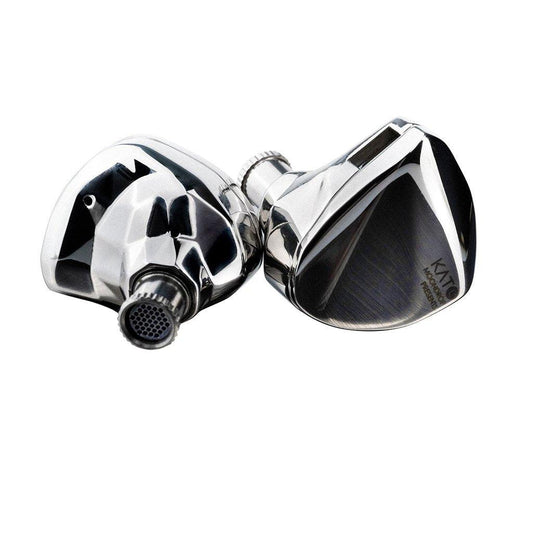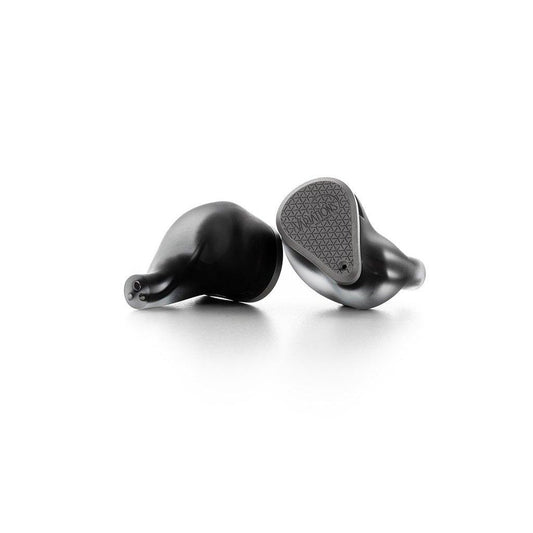Moondrop - The Secret Behind Chi-Fi's Most Successful IEM Company

Introduction
Moondrop is a name that has become synonymous with affordable, quality sound and infamous waifu marketing in the last few years. To understand how this happened, we have to take a step back to the pre-2020 era of the IEM industry. This was a time when Chi-Fi (a term often used to describe low-cost sets built out of China) was often looked down upon. And for a reason: many manufacturers were slinging proverbial mud at the wall to see what stuck. With few well-tuned Chi-Fi IEMs, not much was sticking.
Enter Moondrop. This company was an early adopter of the Harman target, based upon the research of Dr. Sean Olive, intended to reflect the aggregate preferences of consumers. Somehow few Chi-Fi manufacturers chose to use this target curve. But Moondrop did, leading to staggering success. The last couple of years have seen the brand become one of the biggest manufacturers and a leader in the IEM scene, so much so that they’re branching out into headphones and ancillary products like keyboards.
Where are they today? Let’s take a closer look at their extensive lineup of IEMs and which ones are worth your time.
The IEMs
Moondrop has made numerous forays into the sub-$50 segment:
- Moondrop Quarks ($13)
- Moondrop Quarks DSP ($15)
- Moondrop Chu ($20)
- Moondrop Spaceship ($20)
- Moondrop SSR / SSP ($40)
- Moondrop LAN ($40)
- Moondrop Nekocake ($42)

Let’s start from the bottom and work our way up. You can take a pass on the Quarks and just pony up the extra two dollars for the DSP version. The DSP version has increased granularity over the stock sound signature which leaves a lot to be desired. It brings it much closer to the Harman target. The Quark’s DSP is USB-C only, though, so iOS users are still out of luck.

The rest of the IEMs on this list are mostly filler, or IEMs that are catering to niche preferences:
- The Spaceship is deprecated.
- The Chu is a middling option for $20 when the Salnotes Zero exists. Only consider it if you like a thinner, brighter sound and are willing to put up with the non-removable cable.
- The SSR/SSP should only be considered options for listeners who prioritize technical performance above all else and are able to sustain its ~13dB of pinna gain which makes it quite shouty. The SSP would be considered the safer option of the two given its extra dash of bass.

Moondrop LAN review unit provided by Shenzhen Audio.
The LAN might be worth a shot for some listeners. It tracks fairly closely to the tried-and-true formula of Moondrop’s iconic single-DD lineup with some idiosyncrasies that seem to stem from less bass quantity. This makes it somewhat harsh-sounding in the 3-5 kHz regions to me. But this would be a fairly natural option for listeners who mostly liked the Chu and wanted something a little safer sounding and more flexible (via the LAN’s detachable cable).

In general, I would pass on any of Moondrop’s TWS IEMs like the Alice, Sparks, or the Nekocake. They all sound pretty average if only thanks to the aid of DSP, but bear in mind that the advantage of TWS earphones is convenience. As far as I can tell, Moondrop’s software implementation is pretty buggy, and it’s difficult to consider these TWS workout-worthy given their build quality. You’re much better off purchasing an established option like the Samsung Galaxy Buds or the Apple AirPods Pro despite the higher cost. And if you’re prioritizing sound quality, then why are you buying TWS? Just stick to wired options instead and thank me later.
Moondrop’s Sub-$100 Single DD
This category encompasses quite a few IEMs from the brand:
- Moondrop Kanas
- Moondrop Kanas Pro
- Moondrop KXXS
- Moondrop KXXX
- Moondrop Starfield
- Moondrop Aria 2
- Moondrop Aria Elven Maiden
- Moondrop Aria Snow

For those unaware, this is the sub-$200 staple IEM that put Moondrop on the map. While the Aria 2 (not to be confused with the original, discontinued Aria) is the most recent iteration, the legacy of this lineup stretches back as far as the original Kanas / Kanas Pro from 2018. Each subsequent iteration has either a) marginally improved the sound signature or b) came with a price cut. But for the most part, these IEMs all sound pretty similar, sporting a warm V-shape signature; there’s a good reason why this is one of the most recommended IEMs in its price bracket. I’d avoid the Aria Snow unless you’re looking for something that sounds a bit colder (but even if this is the case, then you’re probably better suited with Moondrop’s cheaper options).
Stellaris ($110)

No way to shy around it, the Stellaris should be a major pass. Not only are its nozzles extremely elongated, making them potentially painful for some listeners, its sound is just as painful—if not more. Nearly 13 decibels of pinna gain at 3kHz in tandem with generous amounts of upper-treble make the Stellaris extremely shouty and bright, even by the questionable standards set by some previous sets like the Moondrop SSR. The bottom line? The Stellaris is nothing more than a poorly-executed cash grab intended to ride the recent planar driver wave.
Moondrop Kato ($190)
The Kato is Moondrop's answer to an upgrade from their $100 single-DD. In most respects, I think this is true. The build and accessories are slightly more premium, and the sound itself offers a slight boost in resolution. This is interesting given that the Kato smooths over some of the upper-treble peak (which one would normally associate with increased resolution) that characterizes its younger $100 brothers. In any case, perhaps this is to attribute for why the Kato is such a safe IEM and makes a good choice for listeners looking for something on the more sterile side (relative to its $100 brothers).

Moondrop Kato In-Ear Headphones
Blessing 2 ($320)
Incidentally, the Moondrop Blessing was one of the first IEMs that I owned, even if it wasn’t a fan of it. The original Blessing wasn’t bad; in fact, it was probably one of the most competent Harman-tuned IEMs at the time of its release. But the Blessing 2 generally elevates things across the board. It packs more punch in the bass (which is still quite weak) alongside moderately improving the treble extension. Overall, the selling point of the Blessing 2 is how well-rounded it is. It’s not perfect, but it’s a pretty safe bet in the $300 crowd.

Blessing 2: Dusk ($330)
What happens when you put the tuning of the already-good B2 into more capable hands? Well, you get the Dusk tuned by the (in)famous IEM reviewer Crinacle. The tonal balance of the Dusk is nothing short of exceptional with a terrific sub-bass shelf and balanced, slightly thicker midrange. There are few IEMs under a grand that top how well this thing's been tuned - although expectedly, the intangibles remain the bottleneck to what is an otherwise terrific IEM. While the Dusk maintains much of what made B2 great, the Dusk's bass is still uncharacteristically dry for a DD, and its imaging isn't quite as good as its brother. But if the B2 was "nothing tops this under $300 good," suffice it to say the Dusk remains in a class of its own at this price point.

Variations ($550)
For the most part, the Variations can be considered an upgraded Blessing 2 Dusk. If the Dusk has what might be considered a balanced sub-bass boost, the Variations is leaning more into subwoofer territory with even more focus in the lowest frequencies. But the biggest upgrade from the Blessing 2 Dusk is no doubt the Variation’s treble response. It’s carried to new heights thanks to not only the addition of an EST tweeter, but also an internal horn which yields a smooth, extended treble response. As far as I’m concerned, this remains the most tasteful rendition of Harman tuning on the market.


Moondrop Variations Tribrid In-Ear Headphones
S8 ($700)
This is an IEM that I still have respect for a couple years later; at one point in time, I even dubbed the S8 “the kilobuck solution”. While this sentiment doesn’t hold as strongly in today’s market, there’s no knocking the S8’s technical prowess and its thin, analytical sound signature. The S8’s highs are incredibly airy and, in conjunction with its strong roots in the Harman IEM target, it’s an IEM truly for the weebs. Read: perfect for aficionados of genres such as K-Pop / J-Pop who like their upper-midrange served to them on a platter.

Illumination ($800)
Don’t let those fancy gold shells fool you. I recall hearing the Illumination for the first time and thinking it sounded alright at best: not alright for $800, just alright period. The Illumination has a typical single-DD presentation from its noticeably blunted transients and generally congested imaging. It’s difficult to say what sets the Illumination apart from its younger single-DD brethren. It certainly does not have superior technical performance. And while tuning is always a matter of preference, I’m even inclined to prefer the tuning of, say, the Moondrop Aria for a fraction of the price. Perhaps this preference stems from the treble response of the Illumination which lacks that extra zing past 10kHz that other single-DD models tend to exhibit.

Solis ($1100)
Released a couple years ago during the peak of the hype for IEMs with EST (electrostatic) drivers, this is still Moondrop’s most expensive IEM. Now, the Solis doesn’t sound bad, but it doesn’t sound good either. It suffers from a lot of the issues that plagued earlier EST IEMs, from hazy treble response to a general sense of weightlessness to its timbre. It also doesn’t have the benefit of a dynamic driver, evidenced by its emphasis on mid-bass and lack of sub-bass extension. It’s not surprising that Moondrop has shied away from more expensive models given the lackluster performance of the Solis, both commercially and in terms of its sound. The CEO of Moondrop himself has gone on the record as saying that he didn’t want to make the Solis, but only did so to cater to the market.

The Bottom Line
You can see that few Moondrop IEMs are outright bad. The brand’s consistency has been one of its main selling points for consumers (I’m definitely missing a joke about anime waifus here, but I digress). Moondrop has also been extremely effective at bringing value to consumers even at the expense of undercutting their own products. But for similar reasons, it’s become readily apparent that Moondrop does not know how to breach the summit-fi market segment. This is evidenced not only by the lackluster performance of their most expensive IEMs, but also by the brand’s efforts to branch outside of the IEM market.
Diversification is a common strategy to mitigate loss (where loss is market share in the IEM sphere). Moondrop has worked their way down to the bottom of the market, and perhaps they feel that they can’t move up. So they are naturally moving outwards into similar products like headphones. But an alternative strategy could be investing more time in R&D to release halo products. This is the structure that many of the most established players like 64 Audio - and some upstarts like Subtonic - in the IEM sphere have used to great effect. By investing in R&D and releasing something truly groundbreaking, I think Moondrop could raise the bar for IEMs and ensure a consistent source of income instead of constantly cycling products that are quickly superseded. Of course, this is all easier said than done. As it stands, first-time consumers are certainly not complaining about reaping the benefits of their current improvement cycles.


